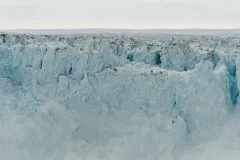Up Close and Personal With the Fastest Glacier in the World

To really see a glacier move, you first have to speed up the passage of time. What appears to be an unmoving frozen expanse, as solid as the ground beneath your feet, is in fact a shape-shifting river of ice. The glacier glides along the ground and the packed snow and ice slowly shift, unseen to the human eye.
We know that they do move, however. Glaciers are huge blocks of compressed snow and ice that can be miles long, wide and deep. They are so heavy that they collapse on the inside, moving downward and outward under their own weight. At the same time, the glacier bottom slides along the ground over a thin film of water, even as bumping over bedrock hills, gravel or debris slows it down. This combined downward, outward and sliding motion is known as glacial flow. As they flow, the pressure and sliding carves out the land below, forming channels and valleys. Meanwhile, in places where ice grows thick and high enough to cover entire landscapes, it can expand outwards from all sides to form continental ice sheets. At the coasts, glaciers flow from the center of these large ice sheets through deep valleys into the sea, where huge icebergs break off (called "calving") and float away.
Glaciologists (scientists who study glaciers) once measured and studied glacial flow by planting survey flags on top of the ice. As the positions of the flags shifted, they could calculate how fast the glacier was moving. Today, these measurements are made more easily and accurately by satellites. Such careful observations over decades allow us to understand time on a glacier's terms.
In 2014, a group of glaciologists found that a Greenland glacier broke the glacial speed record. It must be an oxymoron, to think that there is a speed record for the term that defines slowness: "a glacial pace." Yet, it's true. A large Greenland glacier named Jakobshavn Isbrae—40 miles long and more than a mile thick—was observed racing into the sea at a rate of more than 10 miles (17 kilometers) per year during 2012. It reached its top speed during the warm summer months, traveling 150 feet (46 meters) per day, faster than any known glacier.
"We are now seeing summer speeds more than four times what they were in the 1990s on a glacier which at that time was believed to be one of the fastest, if not the fastest, glaciers in Greenland," Ian Joughin, a glaciologist at the University of Washington in Seattle, told the BBC.
While Jakobshavn Isbrae is the fastest, it is one among many Greenland glaciers that have picked up their pace over the last decade. These accelerating glaciers have something in common: they are all on the edge of the ice sheet and moving toward the ocean. The exact reasons why they are speeding up aren't known for sure. But glaciologists have some ideas, and most are related to climate change. In Jakobshavn's case, it appears that the floating edge (called the "terminus") has melted enough (possibly from warming seawater) that it is no longer touching the seafloor. Without the solid ice wedging into the seafloor like a doorstop, the glacier can move more quickly. Another possibility is that meltwater from the glacier surface (a result of warming air temperatures) is making its way through cracks to the bottom of the glacier. This extra slippery water allows the glacier to glide more easily and quickly along the ground.
The rapid delivery of inland glacial ice into the sea is expected to make major contributions to sea level rise. Ice melt from Greenland has raised global sea levels by more than a quarter-inch in the past 20 years, and it's estimated that the three largest glaciers are responsible for one-fifth of the meltwater flowing from Greenland into the ocean. As Jakobshavn Isbrae moves faster, it may contribute more to rising seas. It has recently calved enormous icebergs—including the largest calving ever caught on film. In May 2014, NASA satellites captured kilometers of ice falling from the front of the glacier in aerial photos. All of this ice and water that was once sitting on land adds to sea level rise.
This glacial speed-up isn't necessarily permanent. Glacier speed varies throughout the year and from year to year; several Greenland glaciers (Helhein and Kangerdlugssuaq) doubled their speeds in the 1990s, but then slowed down by 2006. It's possible that Jakobshavn will join them. But it's also possible that an increasingly warm atmosphere and ocean will hit the glacial gas pedal, driving ice and meltwater even more quickly into the sea.
All photos of Jakobshavn Isbrae by Nik Gaffney and used with his permission. View his full album of photographs, taken in June 2014. Article reviewed by Sarah Das, a glaciologist at Woods Hole Oceanographic Institution.






